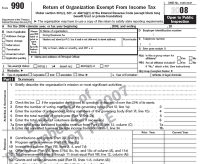 What would be the accounting transaction recorded by a 501(c)3 organization for a permanently restricted donation received?
What would be the accounting transaction recorded by a 501(c)3 organization for a permanently restricted donation received?
The particulars will depend on what accounting software you are using. Basically you would debit cash or receivables (depending on if you got the money or just a letter saying you were getting the money) and credit an income account. If you are using QuickBooks you also would code the income to a ‘class’ that is called something like ‘permanently restricted funds’ and to the particular funder (customer / job).
I’m new to a nonprofit board. Big discussion always about the income statement which shows a multi-year grant vs. the expense of that money. Is the income booked in the current fiscal year of receipt and the expense booked in the next fiscal year of expense? Or, are they both booked in the year of expense, which is in this example the next year, and is what I would do in the private sector with a pre-paid item? Is there a difference in the answer depending upon whether the money was received or merely pledged?
Also, can you recommend a good nonprofit accounting starter guide or overview?
First off I’d recommend this book. Short, easy to read and great basic financial information for nonprofit staff and managers. There are lots of other great books out there but this is always the first place I look when I have a question.
You have touched on one of the big issues of nonprofit accounting. The matching principal in regular accounting gets thrown out the door for the most part. For what you describe above the 100,000 is booked as income for this fiscal year. Next fiscal year will have all the expenses and the nonprofit will need to figure out a way to explain this that will make sense to folks.
One way I recommend adding in an income item in a P&L report called “grant monies released from restriction.” As you do the work that the 100,000 is paying for you can ‘add’ income here to balance the expenses. This addition of income is actually a release of funds from restricted monies to unrestricted monies, not just revenue pulled out of the air.
As for pledge or cash, it matters when you are promised, or pledged the monies. If you get a letter from the funder at the end of this fiscal year awarding you the grant but don’t actually received checks until next FY, it is still considered revenue to the organization when you received that first official notification.
 The IRS had their Exempt Organization Workshops this month, a day spent going over nonprofit and tax exempt issues. I picked up a couple of nice tidbits that I will share but first I want to go over two other items. The first is the IRS’s Winter 2009 Statistics Of Income Bulletin. It covers all types of tax returns but a highlight of the nonprofit sector:
The IRS had their Exempt Organization Workshops this month, a day spent going over nonprofit and tax exempt issues. I picked up a couple of nice tidbits that I will share but first I want to go over two other items. The first is the IRS’s Winter 2009 Statistics Of Income Bulletin. It covers all types of tax returns but a highlight of the nonprofit sector:

